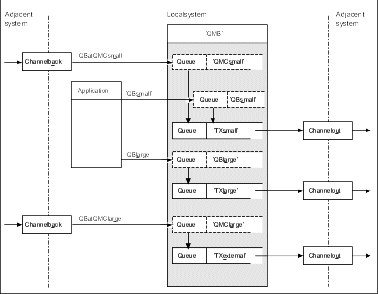In a distributed-queuing environment, the need to separate messages to the
same queue manager into different message flows can arise for a number of
reasons. For example:
- You may need to provide a separate flow for very large, medium, and small
messages. This also applies in a clustering environment and, in this
case, you may create clusters that overlap. There are a number of
reasons you might do this, for example:
- To allow different organizations to have their own administration.
- To allow independent applications to be administered separately.
- To create a class of service. For example you could have a cluster
called STAFF that is a subset of the cluster called STUDENTS. When you
put a message to a queue advertised in the STAFF cluster, a restricted channel
is used. When you put a message to a queue advertised in the STUDENTS
cluster, either a general channel or a restricted channel may be used.
- To create test and production environments.
- It may be necessary to route incoming messages via different paths from
the path of the locally generated messages.
- Your installation may require to schedule the movement of messages at
certain times (for example, overnight) and the messages then need to be stored
in reserved queues until scheduled.
Figure 23. Separating messages flows

In the example shown in Figure 23, the two incoming flows are to alias queue manager names
'QMC_small' and 'QMC_large'. You provide these flows
with a queue manager alias definition to capture these flows for the local
queue manager. You have an application addressing two remote queues and
you need these message flows to be kept separate. You provide two
remote queue definitions that specify the same location, 'QMC', but
specify different transmission queues. This keeps the flows separate,
and nothing extra is needed at the far end as they have the same destination
queue manager name in the transmission headers. You provide:
- The incoming channel definitions
- The two remote queue definitions QB_small and QB_large
- The two queue manager alias definitions QMC_small and QMC_large
- The three sending channel definitions
- Three transmission queues: TX_small, TX_large, and TX_external
| Coordination with adjacent systems |
|---|
|
When you use a queue manager alias to create a separate message flow, you
need to coordinate this activity with the system administrator at the remote
end of the message channel to ensure that the corresponding queue manager
alias is available there. |
© IBM Corporation 2002. All Rights Reserved

